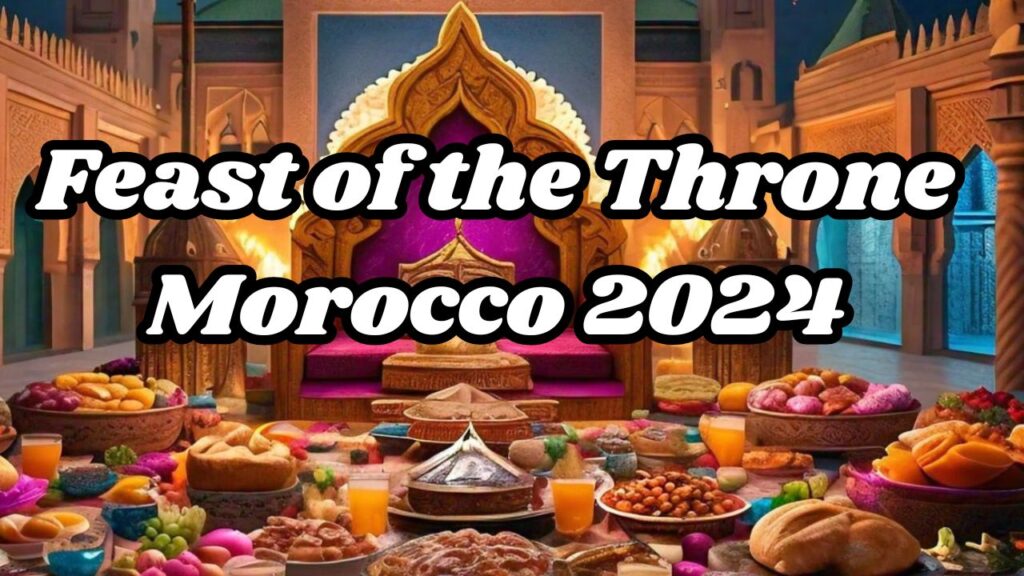Feast of the Throne Morocco: Interesting Facts 2024 and History

Feast of the Throne, Feast of the Throne in Morocco
The Feast of the Throne (Fête du Trône) is a significant national holiday in Morocco, celebrated annually on July 30th. This day commemorates the ascension of the current king to the throne. Key aspects of the celebration include the following:
- Historical Significance: The Feast of the Throne marks the anniversary of King Mohammed VI’s accession to the throne on July 30, 1999, following the death of his father, King Hassan II.
- Ceremonies and Festivities: The day is marked by various official ceremonies, including a royal speech, military parades, and other events that highlight Morocco’s history, culture, and achievements.
- Royal Address: A significant part of the celebrations is the king’s speech, where he addresses the nation, reflecting on the past year’s progress and outlining future goals and plans.
- Decorations and Celebrations: Public buildings, streets, and homes are often decorated with Moroccan flags and portraits of the king. Numerous cultural events, exhibitions, and festivities are held nationwide.
- Community Involvement: The Feast of the Throne is a time for Moroccans to express their loyalty and affection for the monarchy. It is a public holiday, so many people have the day off work to participate in the celebrations.
Feast of the Throne in Morocco History
The Feast of the Throne, or Fête du Trône, is a national celebration in Morocco with deep historical and cultural roots. Let’s take a detailed look at its historical background:
Origins and Evolution
- Early Beginnings: The tradition of celebrating the accession of Moroccan monarchs dates back to the early 20th century. The first official celebration of the Feast of the Throne took place in 1934, during the reign of King Mohammed V. This event marked the beginning of the annual celebration, which has since become one of the most important national holidays in Morocco.
- Colonial Context: During the French and Spanish protectorates (1912-1956), the celebration of the Feast of the Throne served as a symbol of national unity and resistance against colonial rule. It was an occasion for Moroccans to express their loyalty to the monarchy and their desire for independence.
- Post-Independence Era: After Morocco gained independence in 1956, the Feast of the Throne took on new significance. It became a celebration not only of the monarchy but also of Moroccan sovereignty and national identity. The holiday has been celebrated every year since, with each king marking the anniversary of his accession to the throne.
Celebrations Under Different Monarchs
- King Mohammed V (1927-1961): Known as the architect of Morocco’s independence, his reign was marked by a strong sense of nationalism. During his time, the Feast of the Throne served as a powerful symbol of resistance and unity.
- King Hassan II (1961-1999): King Hassan II’s tenure was characterized by the modernization and strengthening of the Moroccan state. The celebrations during his era were marked by grand ceremonies and significant national projects, emphasizing development and progress.
- King Mohammed VI (1999-present): King Mohammed VI’s accession to the throne on July 30, 1999, brought a new era of reforms and modernization. The Feast of the Throne under his reign has focused on themes of development, social justice, and economic progress. His speeches on this day often highlight achievements and outline future goals.
Cultural and Social Significance
- National Unity: The Feast of the Throne is a day when Moroccans across the country come together to celebrate their heritage and express their loyalty to the monarchy. It reinforces national unity and pride.
- Reflection and Progress: The king’s address to the nation is a key component of the celebrations, offering an opportunity to reflect on the country’s progress and challenges. It sets the tone for future initiatives and policies.
- Festivities and Traditions: The day is marked by various events, including parades, fireworks, cultural performances, and community gatherings. Public buildings and homes are decorated with Moroccan flags and portraits of the king.
Conclusion
The Feast of the Throne in Morocco is more than just a celebration of the monarchy; it is a reflection of the country’s history, struggles, and aspirations. It symbolizes the enduring bond between the Moroccan people and their kings, serving as a reminder of the nation’s unity and resilience.
What is Throne Day in Morocco
Throne Day (Eid al-ʿArsh) is a significant national holiday in Morocco, celebrated annually on July 30th. It commemorates the accession of King Mohammed VI to the throne in 1999, following the death of his father, King Hassan II.
On this day, Moroccans celebrate the monarch’s enthronement and express loyalty and allegiance to the royal family. The festivities include:
1. Ceremonial events at the Royal Palace in Rabat
2. Military parades and processions
3. Traditional music and dance performances
4. Decorations and illuminations in streets and buildings
5. Religious ceremonies and prayers
6. Family gatherings and feasts
7. Flag-raising ceremonies
Throne Day is an opportunity for Moroccans to come together, honor their monarch, and celebrate national unity and stability. It’s a joyous occasion filled with patriotism, tradition, and celebration!
